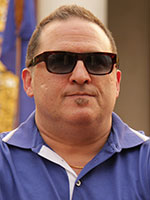Dr. Peter A. Newman
Where Social Science Meets Basic Science
Professor, University of Toronto

Dr. Peter A. Newman, Canada Research Chair in Health and Social Justice at the Factor-Inwentash Faculty of Social Work at the University of Toronto, firmly believes in multidisciplinarity in HIV research. “When social and biomedical sciences work in tandem it can translate the great science that’s happening into tools that are meaningful and effective,” says Dr. Newman. His research takes HIV treatment and prevention methods that are in development through basic and clinical sciences, and applies them to “the most important laboratory—the real world”—to see how they can have the greatest potential. “You can have the most amazing technology—even a vaccine that is highly efficacious” says Dr. Newman, “but if you can’t get that vaccine out to the people who will need it, or they refuse to use it because they are too afraid, or they don’t understand it, that vaccine is going to be virtually worthless to populations at high risk.”
Working with a CIHR Team grant through the Canadian HIV Vaccine Initiative, and a CIHR Operating grant, Dr. Newman is investigating the potential of HIV prevention methods for use by MSM and transgender women in India and Thailand. In the last decade, rates of HIV among most populations in India and Thailand have gone down but MSM and transgender women continue to be at very high risk—in some Indian and Thai cities HIV prevalence among MSM and trans women is estimated from 15% to 30%. “We’re looking at the acceptability of new technologies that are either just emerging or on the horizon,” explains Dr. Newman. Though some of these types of studies have been done in North America, Dr. Newman explains that culturally, both India and Thailand are very different. “Some of the issues with acceptability cross national boundaries but some are distinct. We have to start from the ground up.” For instance, family is a centrally important part of life in India and Thailand; in India, in particular, many MSM are married to women. It raises some big questions around disclosure, treatment, and prevention. “What if their status is disclosed and someone finds out? Or where are they going to keep the medicine where their mother or wife doesn’t see it? So the risk is huge, potentially losing your family, your wife, or your male partner—major sources of love and support—is pretty severe,” says Dr. Newman. “In some cases the risks to using HIV prevention or treatment may seem to outweigh the benefits; it’s up to us to work together to change the social and structural factors that inform that equation.” In addition, he is working on some of the logistics and challenges around clinical trial participation. India requires that all drugs used are tested in clinical trials within its borders. But, there are some difficulties and barriers to participating in clinical trials. “In addition to fears about disclosure that one is an MSM or seen to be at high risk for HIV, a lot of issues come up about insurance; people are very concerned about side effects and they worry about who will take care of their family if something happens to them in the trial.”
Ultimately, he says this kind of systematic and detailed study in collaboration with key populations will ensure the best use of prevention and treatment methods as they become available. “We can’t dictate what products are out there, but we try to make information that we garner available at the grassroots level to inform advocacy efforts on the part of communities and policies to support how you might implement new prevention tools in a way that would be the most socially acceptable and user friendly.”
Evident in his research, Dr. Newman believes it’s critical that key populations and disenfranchised people are included in studies of acceptability and applicability. And it’s no wonder—he was graduating university when the first cases of HIV were identified in the early 80s. He worked as a volunteer on hotlines in Boston and as a social worker in the largest public health AIDS clinic in the US, helping people living with HIV when very few options for treatment were available. “It was a very intense experience,” he says. Since then, he has become an advocate for the disenfranchised, trying to give a voice to those who often go unheard. “I try to use very cool and cutting edge research methods to represent people’s truths as accurately as possible but also in a way that speaks to policy makers and to funders. You can use state of the art research methods to help represent the needs and priorities of vulnerable populations in low- and middle-income countries. For me, that’s a powerful paradigm that I like to work in.”
The Canadian Association for HIV Research (CAHR), the CIHR HIV/AIDS Research Initiative, the Canadian Foundation for AIDS Research (CANFAR), the CIHR Canadian HIV Trials Network (CTN) and the Canadian HIV Vaccine Initiative (CHVI) Research and Development Alliance Coordinating Office (ACO) would like to thank Dr. Newman for his significant contributions to our understanding of HIV. His work is part of a larger Canadian research effort that is making a difference in the lives of those affected by HIV in Canada and around the world.
- Date modified: